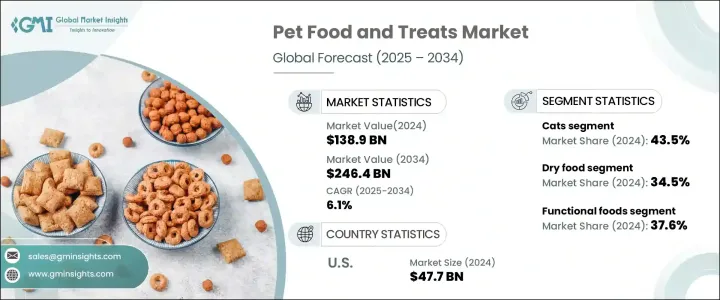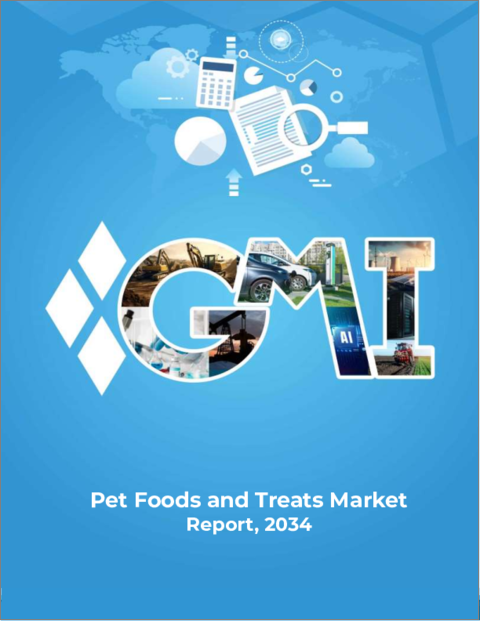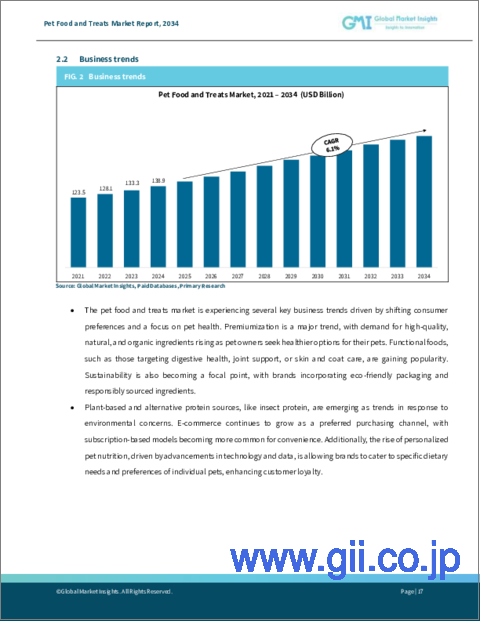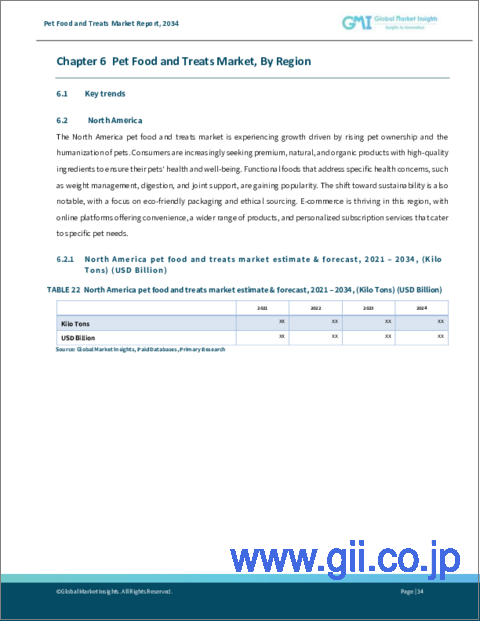|
|
市場調査レポート
商品コード
1698582
ペットフード・おやつの市場機会、成長促進要因、産業動向分析、2025年~2034年の予測Pet Food and Treats Market Opportunity, Growth Drivers, Industry Trend Analysis, and Forecast 2025-2034 |
||||||
カスタマイズ可能
|
|||||||
| ペットフード・おやつの市場機会、成長促進要因、産業動向分析、2025年~2034年の予測 |
|
出版日: 2025年02月13日
発行: Global Market Insights Inc.
ページ情報: 英文 220 Pages
納期: 2~3営業日
|
全表示
- 概要
- 目次
ペットフード・おやつの世界市場は、2024年には1,389億米ドルとなり、2025年から2034年にかけてCAGR6.1%で成長すると予測されています。
ペットの飼い主がペットの健康と幸福を優先するため、プレミアムペットフードへの支出が増加し、高品質の原材料への需要が高まっています。消費者は、栄養価の高さと嗜好性の向上を両立させた斬新な原材料を求めています。プレミアム化と呼ばれるこの動向は、優れた品質を維持しながらペットの食事ニーズに応えるよう設計された革新的な配合の機会を生み出しています。

ペットが家族の一員と見なされるようになったことで、飼い主は認知度の高い高品質の原材料を使用したプレミアムペットフード製品への投資を厭わなくなっています。プレミアムペットフード市場は、本物の肉源、果物、野菜、全粒穀物を含む一方で、充填物、製品別、人工添加物を避けることで差別化を図っています。ドライフード分野は、広く受け入れられ利便性が高いことから、2024年のペットフード・おやつ市場で34.5%のシェアを占めました。
| 市場範囲 | |
|---|---|
| 開始年 | 2024年 |
| 予測年 | 2025年~2034年 |
| 開始金額 | 1,389億米ドル |
| 予測金額 | 2,464億米ドル |
| CAGR | 6.1% |
標準的なペットフードには、肉や肉製品別が約14%から17%含まれ、穀物、ビタミン、ミネラルも含まれています。米国だけでも300社以上のメーカーが年間約700万トンのペットフードを生産しており、ドライフードや缶詰からセミモイストタイプ、ビスケット、キブル、おやつまで幅広い選択肢を提供しています。ドライフードの水分含有率は一般に10%から12%であるのに対し、ウェットフードの水分含有率は70%から80%です。
2024年のペットフード・おやつ市場では、キャットフードセグメントが43.5%以上を占めていますが、ドッグフードの需要は他のペットカテゴリーに比べて6.2%高い成長を記録し、より速いペースで増加しています。犬用と猫用のドライフードの売上高は、2022年と2023年に著しい成長を遂げました。ドッグフードのドライフードの売上高は13億米ドルに達し、19.7%の伸びを示す一方、キャットフードのドライフードの売上高は6億米ドルに達し、21.8%の伸びを示します。ウェットドッグフードとキャットフードの売上も、それぞれ12.5%と14.6%増加しました。
ペットフード市場では、押出しドライキブルが依然として主流で、売上の57%を占めています。さらに、犬の飼い主の60%以上と猫の飼い主の69%以上が定期的にペットにキブルフードを与えていますが、ペットの何割かは缶詰も毎日食べています。2024年には、市場は原材料のタイプ別に、タンパク質、穀類と野菜、油脂、ビタミンとミネラルに区分されました。機能性食品は37.6%の売上シェアを占め、栄養的に完全な市販ペットフードの基盤となっています。
菜食主義者や穀物不使用のペットフードへの関心の高まりが、味、食感、風味を高めるための代替原材料、特に果物や野菜への需要を促進しています。米国のペットフード・おやつ市場は2024年に477億米ドルに達し、収益の約55%は缶詰、セミモイスト、冷蔵ペットフードなど、キブル以外の代替形態によるものです。冷蔵ペットフードのシェアは現在4%とわずかですが、年間35%の成長率で拡大しています。
目次
第1章 調査手法と調査範囲
- 市場範囲と定義
- 基本推定と計算
- 予測計算
- データソース
- 一次
- 二次
- 有料ソース
- 公的ソース
- 一次調査と検証
- 一次ソース
- データマイニングソース
第2章 エグゼクティブサマリー
第3章 業界洞察
- 業界エコシステム分析
- バリューチェーンに影響を与える要因
- 利益率分析
- 変革
- 将来の展望
- メーカー
- 流通業者
- サプライヤーの状況
- 利益率分析
- 主要ニュース
- 規制状況
- 影響要因
- 成長促進要因
- プレミアムペットフードに対する需要の高まり
- 世界のペット飼育率の増加
- eコマースによるペットフード販売の拡大
- 業界の潜在的リスク・課題
- プレミアムペットフードのコスト高
- ペットフードの厳しい安全規制
- 成長促進要因
- 成長可能性分析
- ポーター分析
- PESTEL分析
第4章 競合情勢
- イントロダクション
- 企業市場シェア分析
- 競合のポジショニングマトリックス
- 戦略展望マトリックス
第5章 市場推計・予測:製品タイプ別、2021年~2034年
- 主要動向
- クッキー、ビスケット、スナック菓子
- 缶詰
- 骨
- ドライフード
- スティック
- その他(フリーズドライフードなど)
第6章 市場推計・予測:ペットタイプ別、2021年~2034年
- 主要動向
- 犬
- 猫
- その他(魚、鳥、ハムスターなど)
第7章 市場推計・予測:成分タイプ別、2021年~2034年
- 主要動向
- タンパク質
- 鶏肉
- 牛肉
- 魚(サーモン、マグロ)
- トルコ
- ラム肉
- 穀類・野菜
- 油脂
- ビタミン・ミネラル
- その他(フレーバーエンハンサー、スペシャリティサプリメントなど)
第8章 市場推計・予測:パッケージ別、2021年~2034年
- 主要動向
- 缶詰
- パウチ
- 袋
- カートン
- その他(缶、チューブなど)
第9章 市場推計・予測:ライフステージ別、2021年~2034年
- 主要動向
- 子犬 / 子猫
- アダルトペット
- シニアペット
第10章 市場推計・予測:特別食ニーズ別、2021年~2034年
- 主要動向
- 体重管理
- グレインフリー
- 低アレルギー性
- オーガニック / ナチュラル
- 生 / フリーズドライ
第11章 市場推計・予測:価格帯別、2021年~2034年
- 主要動向
- 低
- 中
- 高
第12章 市場推計・予測:流通チャネル別、2021年~2034年
- 主要動向
- オンライン
- eコマース
- 企業ウェブサイト
- オフライン
- スーパーマーケット / 食料品店
- ペット専門店
- 小売店
- 動物病院
第13章 市場推計・予測:地域別、2021年~2034年
- 主要動向
- 北米
- 米国
- カナダ
- 欧州
- ドイツ
- 英国
- フランス
- スペイン
- イタリア
- ロシア
- アジア太平洋
- 中国
- インド
- 日本
- オーストラリア
- 韓国
- ラテンアメリカ
- ブラジル
- メキシコ
- 中東・アフリカ
- サウジアラビア
- 南アフリカ
- アラブ首長国連邦
第14章 企業プロファイル
- Agrolimen S.A.
- Big Heart Pet Brands, Inc.
- Blue Buffalo Pet Products, Inc.
- Diamond Pet Foods
- Freshpet
- General Mills, Inc.
- Heristo AG
- Hill’s Pet Nutrition, Inc.
- Mars Petcare US, Inc.
- Nestlé Purina PetCare Company
- Nisshin Pet Food, Inc.
- Nutriara Alimentos Ltda
- The J.M. Smucker Company
- WellPet LLC
The Global Pet Food And Treats Market was valued at USD 138.9 billion in 2024 and is projected to grow at a 6.1% CAGR from 2025 to 2034. Increased spending on premium pet food is driving demand for high-quality ingredients as pet owners prioritize their pets' health and well-being. Consumers are seeking novel ingredients that offer both nutritional benefits and enhanced taste. This trend, known as premiumization, is creating opportunities for innovative formulations designed to cater to pets' dietary needs while maintaining superior quality.

With pets increasingly seen as family members, owners are willing to invest in premium pet food products that feature recognizable, high-quality ingredients. The market differentiates premium pet food by including real meat sources, fruits, vegetables, and whole grains while avoiding fillers, by-products, and artificial additives. The dry food segment held a 34.5% share of the pet food and treats market in 2024, owing to its widespread acceptance and convenience.
| Market Scope | |
|---|---|
| Start Year | 2024 |
| Forecast Year | 2025-2034 |
| Start Value | $138.9 Billion |
| Forecast Value | $246.4 Billion |
| CAGR | 6.1% |
Standard pet food contains approximately 14 to 17 percent meat and meat by-products, along with cereals, grains, vitamins, and minerals. In the United States alone, over 300 manufacturers produce around 7 million tons of pet food annually, offering a vast selection ranging from dry and canned options to semi-moist varieties, biscuits, kibbles, and treats. Dry pet food generally contains 10 to 12 percent moisture, whereas wet food has a moisture content ranging from 70 to 80 percent.
The cat food segment accounted for over 43.5% of the pet food and treats market in 2024, while the demand for dog food is rising at a faster rate, registering 6.2% higher growth compared to other pet categories. Both dog and cat dry food sales experienced significant growth in 2022 and 2023. Sales of dry dog food reached USD 1.3 billion, reflecting a 19.7% increase, while dry cat food sales amounted to USD 0.6 billion, marking a 21.8% growth. Wet dog and cat food sales also expanded by 12.5% and 14.6%, respectively.
Extruded dry kibble remains the dominant choice in the pet food market, accounting for 57% of sales. Additionally, over 60% of dog owners and 69% of cat owners regularly feed their pets kibble, despite a percentage of pets also consuming canned food daily. In 2024, the market was segmented by ingredient type into proteins, cereals and vegetables, fats and oils, and vitamins and minerals. Functional foods commanded a 37.6% revenue share, serving as a foundation for nutritionally complete commercial pet food.
The rising interest in vegan and grain-free pet food options is fueling demand for alternative ingredients, particularly fruits and vegetables, to enhance taste, texture, and flavor. The US pet food and treats market reached USD 47.7 billion in 2024, with approximately 55% of revenue coming from alternative formats beyond kibble, including canned, semi-moist, and refrigerated pet food. While refrigerated pet food currently holds a modest 4% share, it is expanding at an annual growth rate of 35%.
Table of Contents
Chapter 1 Methodology & Scope
- 1.1 Market scope & definition
- 1.2 Base estimates & calculations
- 1.3 Forecast calculation
- 1.4 Data sources
- 1.4.1 Primary
- 1.4.2 Secondary
- 1.4.2.1 Paid sources
- 1.4.2.2 Public sources
- 1.5 Primary research and validation
- 1.5.1 Primary sources
- 1.5.2 Data mining sources
Chapter 2 Executive Summary
- 2.1 Industry synopsis, 2021-2034
Chapter 3 Industry Insights
- 3.1 Industry ecosystem analysis
- 3.1.1 Factor affecting the value chain
- 3.1.2 Profit margin analysis
- 3.1.3 Disruptions
- 3.1.4 Future outlook
- 3.1.5 Manufacturers
- 3.1.6 Distributors
- 3.2 Supplier landscape
- 3.3 Profit margin analysis
- 3.4 Key news & initiatives
- 3.5 Regulatory landscape
- 3.6 Impact forces
- 3.6.1 Growth drivers
- 3.6.1.1 Rising demand for premium pet food
- 3.6.1.2 Increasing pet adoption rates globally
- 3.6.1.3 Expansion of e-commerce pet food sales
- 3.6.2 Industry pitfalls & challenges
- 3.6.2.1 High costs of premium pet food
- 3.6.2.2 Stringent pet food safety regulations
- 3.6.1 Growth drivers
- 3.7 Growth potential analysis
- 3.8 Porter's analysis
- 3.9 PESTEL analysis
Chapter 4 Competitive Landscape, 2024
- 4.1 Introduction
- 4.2 Company market share analysis
- 4.3 Competitive positioning matrix
- 4.4 Strategic outlook matrix
Chapter 5 Market Estimates and Forecast, By Product Type, 2021 – 2034 (USD Billion) (Kilo Tons)
- 5.1 Key trends
- 5.2 Cookies, biscuits, snacks
- 5.3 Canned food
- 5.4 Bones
- 5.5 Dry food
- 5.6 Sticks
- 5.7 Others (Freeze-dried food, etc.)
Chapter 6 Market Estimates and Forecast, By Pet Type, 2021 – 2034 (USD Billion) (Kilo Tons)
- 6.1 Key trends
- 6.2 Dogs
- 6.3 Cats
- 6.4 Others (fish, birds, hamsters, etc.)
Chapter 7 Market Estimates and Forecast, By Ingredient Type, 2021 – 2034 (USD Billion) (Kilo Tons)
- 7.1 Key trends
- 7.2 Proteins
- 7.2.1 Chicken
- 7.2.2 Beef
- 7.2.3 Fish (salmon, tuna)
- 7.2.4 Turkey
- 7.2.5 Lamb
- 7.3 Cereals & Vegetables
- 7.4 Fats and oils
- 7.5 Vitamins & Minerals
- 7.6 Others (Flavour Enhancers, Specialty Supplemental, etc.)
Chapter 8 Market Estimates and Forecast, By Packaging, 2021 – 2034 (USD Billion) (Kilo Tons)
- 8.1 Key trends
- 8.2 Cans
- 8.3 Pouches
- 8.4 Bags
- 8.5 Carton
- 8.6 Others (tins, tubs, etc.)
Chapter 9 Market Estimates and Forecast, By Life Stage, 2021 – 2034 (USD Billion) (Kilo Tons)
- 9.1 Key trends
- 9.2 Puppy/kitten
- 9.3 Adult pet
- 9.4 Senior pet
Chapter 10 Market Estimates and Forecast, By Special Dietary Needs, 2021 – 2034 (USD Billion) (Kilo Tons)
- 10.1 Key trends
- 10.2 Weight management
- 10.3 Grain-free
- 10.4 Hypoallergenic
- 10.5 Organic/natural
- 10.6 Raw/freeze-dried
Chapter 11 Market Estimates and Forecast, By Price Range, 2021 – 2034 (USD Billion) (Kilo Tons)
- 11.1 Key trends
- 11.2 Low
- 11.3 Medium
- 11.4 High
Chapter 12 Market Estimates and Forecast, By Distribution Channel, 2021 – 2034 (USD Billion) (Kilo Tons)
- 12.1 Key trends
- 12.2 Online
- 12.2.1 E-commerce
- 12.2.2 Company websites
- 12.3 Offline
- 12.3.1 Supermarkets/grocery stores
- 12.3.2 Pet specialty stores
- 12.3.3 Retailers
- 12.3.4 Veterinary clinics
Chapter 13 Market Estimates and Forecast, By Region, 2021 – 2034 (USD Billion) (Kilo Tons)
- 13.1 Key trends
- 13.2 North America
- 13.2.1 U.S.
- 13.2.2 Canada
- 13.3 Europe
- 13.3.1 Germany
- 13.3.2 UK
- 13.3.3 France
- 13.3.4 Spain
- 13.3.5 Italy
- 13.3.6 Russia
- 13.4 Asia Pacific
- 13.4.1 China
- 13.4.2 India
- 13.4.3 Japan
- 13.4.4 Australia
- 13.4.5 South Korea
- 13.5 Latin America
- 13.5.1 Brazil
- 13.5.2 Mexico
- 13.6 Middle East and Africa
- 13.6.1 Saudi Arabia
- 13.6.2 South Africa
- 13.6.3 UAE
Chapter 14 Company Profiles
- 14.1 Agrolimen S.A.
- 14.2 Big Heart Pet Brands, Inc.
- 14.3 Blue Buffalo Pet Products, Inc.
- 14.4 Diamond Pet Foods
- 14.5 Freshpet
- 14.6 General Mills, Inc.
- 14.7 Heristo AG
- 14.8 Hill’s Pet Nutrition, Inc.
- 14.9 Mars Petcare US, Inc.
- 14.10 Nestlé Purina PetCare Company
- 14.11 Nisshin Pet Food, Inc.
- 14.12 Nutriara Alimentos Ltda
- 14.13 The J.M. Smucker Company
- 14.14 WellPet LLC






